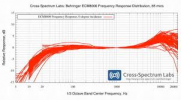- Frequency response measurements by "cumulative white noise averaging":
#392
- Where in my multichannel multi-driver (multi-way) multi-amplifier stereo system should I measure/check frequency (Fq) Responses?
#393
- Frequency (Fq) responses in the completed system measured by using “cumulative white noise averaging method” under the present standard crossover configurations and relative gains_
Part-1_Fq Responses in EKIO’s digital output level:
#394
- Frequency (Fq) responses in the completed system measured by using “cumulative white noise averaging method” under the present standard crossover configurations and relative gains_
Part-2_Fq Responses in DAC8PRO’s analog output level:
#396
- Frequency (Fq) responses in the completed system measured by using “cumulative white noise averaging method” under the present standard crossover configurations and relative gains_
Part-3_Fq Responses in amplifiers’ SP output level before protection capacitors:
#401
- Frequency (Fq) responses in the completed system measured by using “cumulative white noise averaging method” under the present standard crossover configurations and relative gains_
Part-4_Fq Responses in amplifiers’ SP output level after protection capacitors:
#402
- Frequency (Fq) responses in the completed system measured by using “cumulative white noise averaging method” under the present standard crossover configurations and relative gains_
Part-5_Fq Responses in actual SP room sound at listening position using one measurement microphone:
#403
- Frequency (Fq) responses in the completed system measured by using “cumulative white noise averaging method” under the present standard crossover configurations and relative gains_
Part-6_Summary, discussions, and a little step forward:
#404,
#405-
#409
- Frequency response in the new (latest) configuration with four amplifiers plus active sub-woofers:
#410
- Frequency response measured under subjectively best fine-tuned gain/volume settings with the four amplifiers plus active sub-woofers:
#411
- Precision measurement and adjustment of time alignment for speaker (SP) units:
Part-1_ Precision pulse wave matching method:
#493
- Precision measurement and adjustment of time alignment for speaker (SP) units:
Part-2_ Energy peak matching method:
#494
- Precision measurement and adjustment of time alignment for speaker (SP) units:
Part-3_ Precision single sine wave matching method in 0.1 msec accuracy:
#504,
#507
- Measurement of transient characteristics of Yamaha 30 cm woofer JA-3058 in sealed cabinet and Yamaha active sub-woofer YST-SW1000:
#495,
#497,
#503,
#507
